In this post:
Your business shouldn't rely solely on paid traffic to attract conversions. Instead, using an SEO strategy along with paid advertising engages consumers and builds brand loyalty. When you use organic search as part of your digital marketing strategy, customers come to you already wanting what you're offering.
After all, these days almost everyone uses the internet to research services and products or learn how to do something new. If you're wondering why you need to develop an SEO strategy, here are ten compelling reasons.
10 compelling reasons for adopting an SEO strategy this year
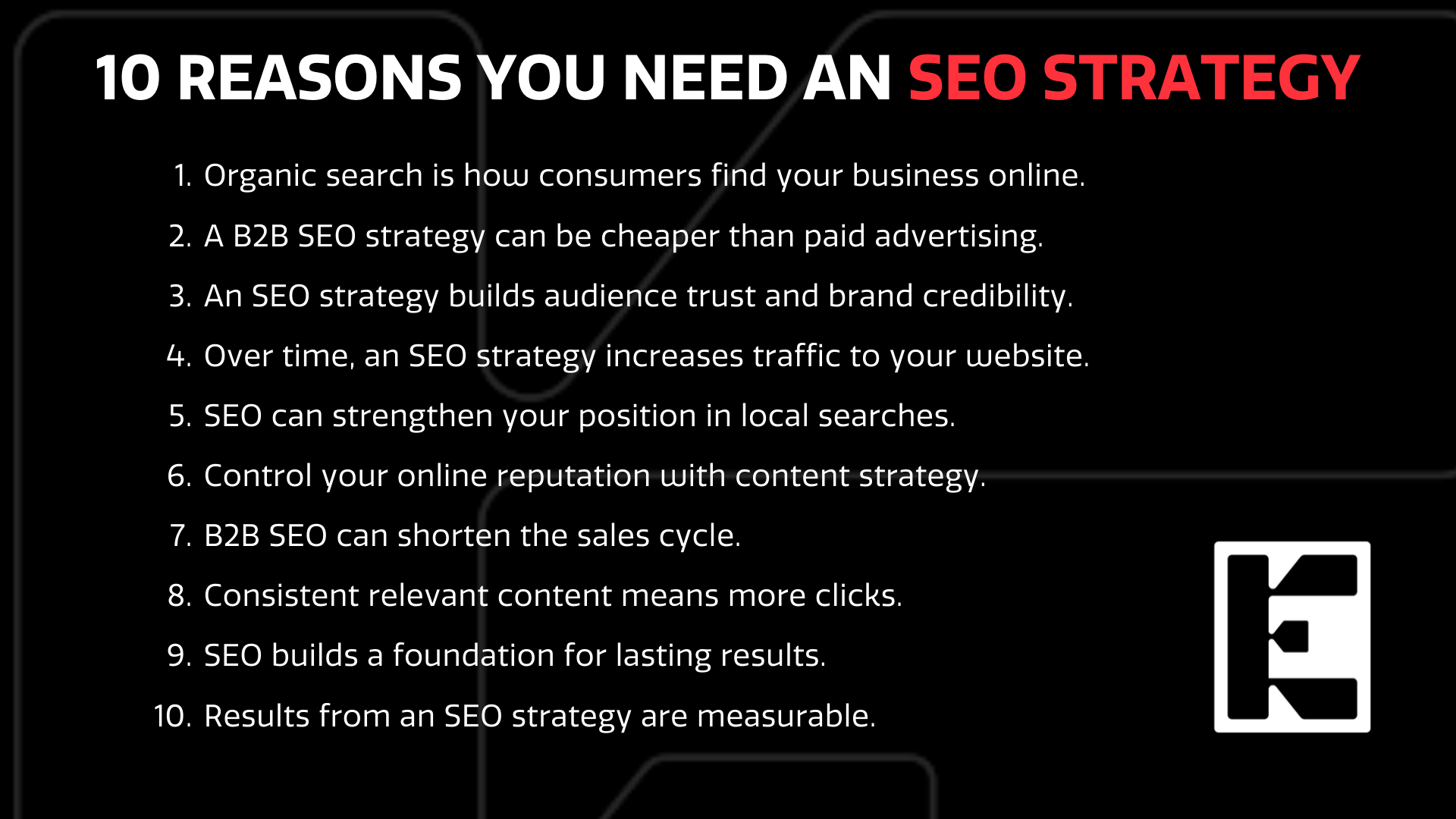
1. Organic search is how consumers find your business online.
Developing an SEO strategy is an effective solution for long-term results. In fact, according to a report from BrightEdge Research, organic search generates 53.3% of all website traffic across industries. What's more, organic search brings in two times more revenue than any other channel for B2B companies.
2. A B2B SEO strategy can be cheaper than paid advertising.
While search engine marketing services cost money, they're typically less expensive than paid advertisements. Not only that, but SEO is an investment with an ROI that continues to pay over time with increased website traffic. You can often start using SEO tools with a free version, then convert to a professional subscription once you've mastered the platform.
Or you can use affordable SEO services from professionals.
3. SEO strategy builds audience trust and brand credibility.
Consumers are looking for more from a brand than a sales pitch. Your audience wants to know what your company stands for, who you employ, and why you do what you do. An SEO strategy implements storytelling techniques and keywords to build a presence online.
For example, you might use optimized video to feature employees or company highlights. You can produce the visual and written content yourself or explore search engine marketing services. A custom design using photography, videography, or motion graphics adds eye-catching visuals to any content.
4. Over time, an SEO strategy increases traffic to your website.
Likewise, great SEO builds credibility with your audience when your website shows up on the first page in a Google search. That kind of search result happens with a combination of providing informative content over time and making your website's user experience part of the SEO strategy.
Google algorithms interpret a website's value based on user experience. Some of the criteria include informative or educational content that satisfies the user's search, smooth navigation, credible images, and optimized elements. Pages that load quickly (especially focusing on mobile-first features), offer seamless navigation, and use optimized forms and features should all be part of the plan.
5. SEO can strengthen your position in local searches.
Local search optimizes a business's online presence, so its web pages show up in search engines for localized searches. For example, a user might search for products or services "near me." Or use similar phrases. When you plan local SEO, remember that it focuses on particular towns, cities, and states. To that end, a local search might be "affordable SEO services near me" or "SEO in Greensboro."
6. Control your online reputation with content strategy.
G2 and Heinz Marketing conducted a survey that revealed 92.4% of respondents said reading a review from a trusted source would make it more likely they would purchase products or services. You can build an outstanding online reputation when you continuously produce content, respond to reviews, and address negative comments.
7. B2B SEO can shorten the sales cycle.
You might use search engine marketing services or create a content strategy plan yourself. Either way, SEO strategy uses content to bring customers to you who want what you're selling. There's no cold calling.
Ideally, your content is engaging and tells your brand story in a way that encourages people to do business with you. Remember, the sales cycle is shorter when your audience has everything they need to make an informed decision. Not only that, but consistency means repeat customers.
8. Consistent relevant content means more clicks.
The more often your content draws people to your website, the higher it ranks on search engines. It's a similar process with social media. SEO strategy includes clickable, highly relevant content that keeps your brand's name in front of your audience and answers the questions they're researching.
Ultimately, more clicks mean more potential business and a higher ROI.
9. SEO builds a foundation for lasting results.
Unlike paid advertising, a consistent organic strategy will increase web traffic over time. Still, an SEO strategy is most powerful when combined with the quick sales that paid advertisements often generate. Today, Growth Marketing is a holistic system in which marketers combine paid advertising and organic content to achieve an agile and data-driven strategy.
10. Results from an SEO strategy are measurable.
Your site generates web traffic from people clicking on search engine results. This organic traffic is measurable. Other metrics include keyword ranking and where your site ends up on the search engine results page (SERP).
Additional metrics include:
- Backlinks
- Page speed
- Time spent on your pages
- Conversion rate
There are hundreds of metrics. However, the click-through rate, bounce rate, and your website's increase in authority over time all clearly illustrate the results of your SEO strategy.
SEO tools of the trade
Now, let's take a closer look at the tools and checklist you need to develop your SEO plan and conduct an audit. Google Analytics and Google Search Console are great places to start. Then you can connect the two and import data for review.
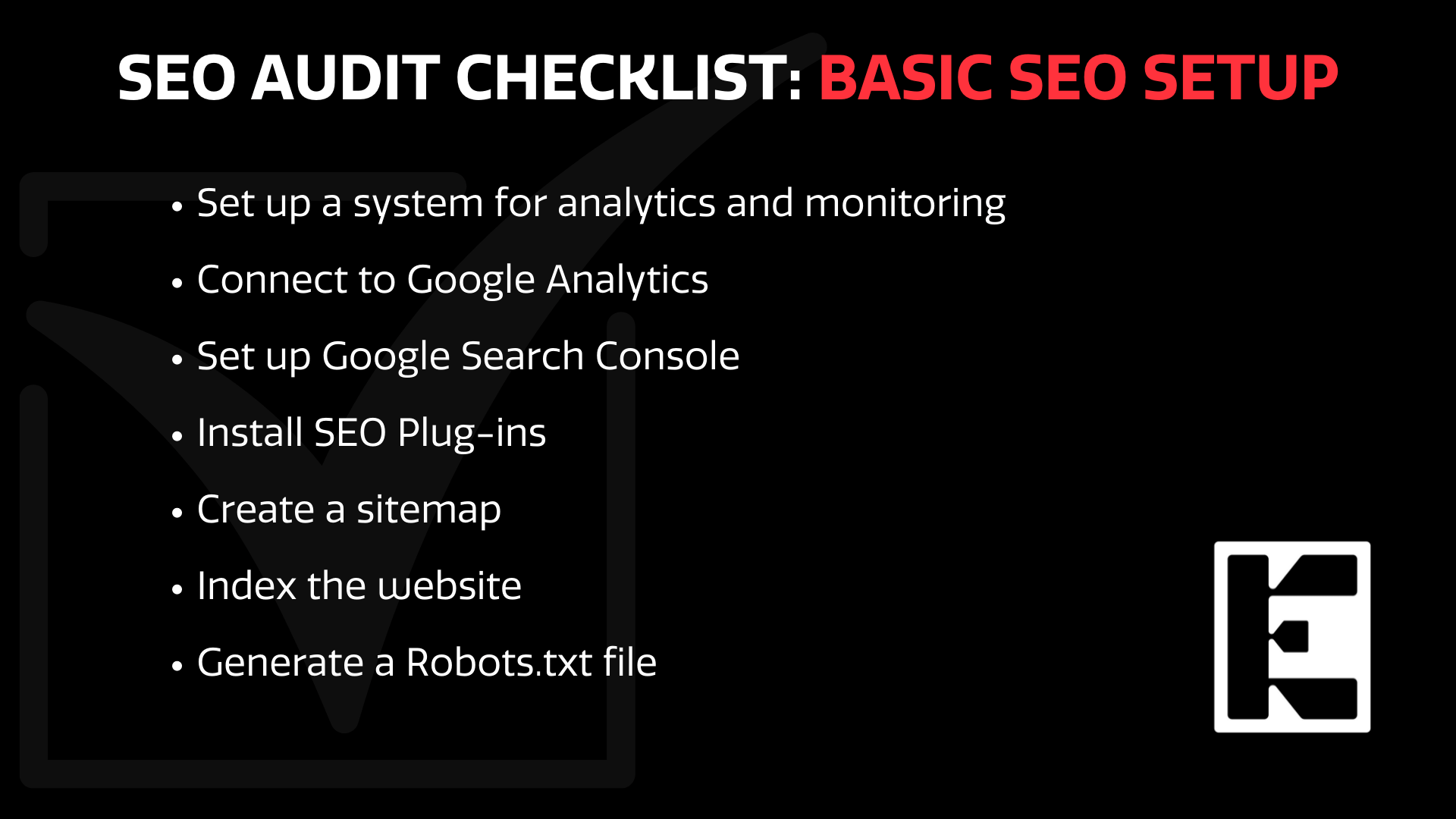
Together, these tools allow you to collect data that will inform your strategy and make it stronger. For example, you can use analytics to determine which topics to focus on and which formats resonate with your audience. The data can also tell you what part of the strategy doesn't work and help you make better decisions.
Similarly, the Google Search Console provides insight into your site's performance with usable data to increase your site's organic traffic. As a side note: You can also set up Google Analytics on your social pages, share posts and articles, and use the data to improve your overall content marketing strategy.
SEO Plugins
Whether you use WordPress or another CMS, you'll find plugins that can enhance SEO with features to help you optimize your site. Yoast for WordPress is one example. This plugin improves content SEO and readability to help you achieve a higher ranking on search engines.
Plug In SEO is another example. It's basically Yoast for Shopify, which manages SEO optimization, improves search rankings, and drives traffic. It also helps you fix headings and image ALT tags, detect and fix broken links (404 pages), and integrates with Google Search Console, among other things.
SEO Audit Checklist: Basic SEO Setup
- Set up a system for analytics and monitoring
- Connect to Google Analytics
- Set up Google Search Console
- Install SEO Plug-ins
- Create a sitemap
- Index the website
- Generate a Robots.txt file
Here are a couple of SEO terms to know:
Crawling is when the search engines follow hyperlinks to discover new content. On the other hand, indexing is the process of storing web pages in an internet database.
A sitemap helps search engines find which pages to crawl, with a list of URLs that specify the main content to index. Likewise, a robots.txt file tells search engines which pages or files not to request from your site.
To get your site indexed, go to Google Search Console and find the URL inspection tool. Then paste the URL into the search bar that you want Google to index. Google will check the URL.
Finally, click request indexing.
👆 Pro Tip: Any time you publish a new page, index it because you're telling Google you've added more information to your site.
Getting started with SEO keyword research
Understanding search terms is vital to success since organic keywords attract traffic. Google processes over 3.5 billion searches per day. That's why well-researched and carefully selected organic keywords can increase your website's visibility.
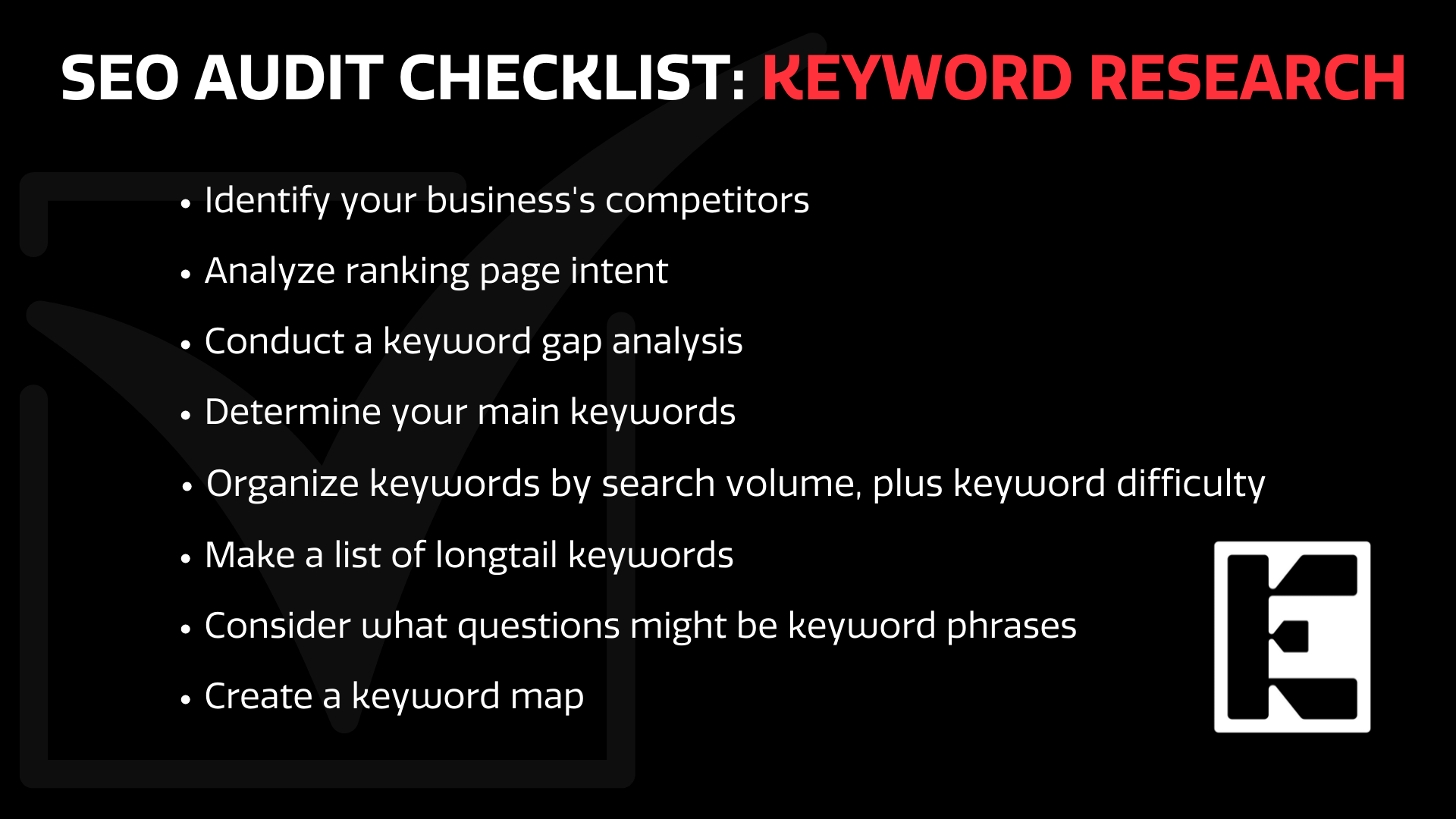
You can use Google Analytics and the Search Console to find and refine keywords for your site, posts, videos, and social pages. In Analytics, select:
- Behavior
- Site Content
- Landing Pages
Next, click on the URL slug, then Secondary Dimension, Advertising, and Keyword. This process allows you to see which keywords are driving traffic to your pages. You can also connect tools like Semrush and Ahrefs to gain further insights.
SEO Audit Checklist: Keyword Research
- Identify your business's competitors
- Analyze ranking page intent
- Conduct a keyword gap analysis
- Determine your main keywords
- Make a list of longtail keywords
- Consider what questions might be keyword phrases
- Organize keywords by search volume, plus keyword difficulty
- Create a keyword map
For example, Ahrefs enables you to optimize your website with a site audit. You can analyze your competitors' keywords, find out what your audience is searching for, and use the keyword explorer to expand your list of relevant search terms.
On-page SEO 101
First, analyze your competitors, find out what your audience is searching for, and use the keyword explorer to expand your list of relevant search terms. On-page SEO includes optimizing the content and source code on web pages for a higher ranking in search engines.
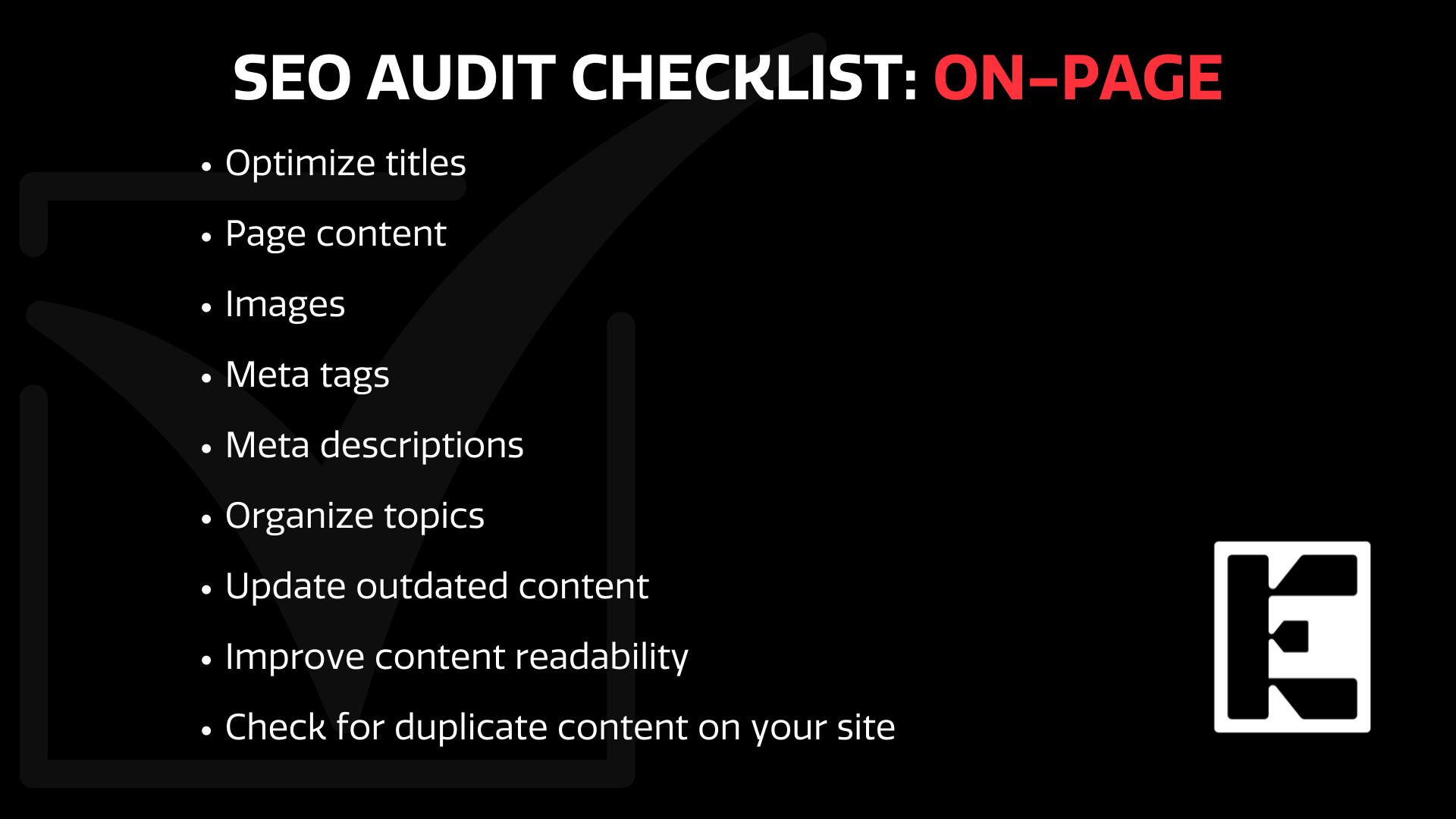
SEO Audit: On-Page Checklist
- Optimize titles
- Page content
- Images
- Meta tags
- Meta descriptions
- Organize topics
- Update outdated content
- Improve content readability
- Delete content that might rank for a duplicate search query
Also, make sure to check for missing, duplicate, and truncated title tags. Search engines display the title tag on results pages as the clickable headline. If it's too long, the title will get truncated or cut off. That's why it's vital to ensure an accurate and concise description of your page's content.
Try this tool from MOZ to check your title tags.
Off-page SEO 101
Off-page SEO is a set of actions you take outside your website that impact your rankings within SERPs. These steps help build your brand's relevance, authority, and engagement. Off-page SEO is all about building and enhancing your web presence.
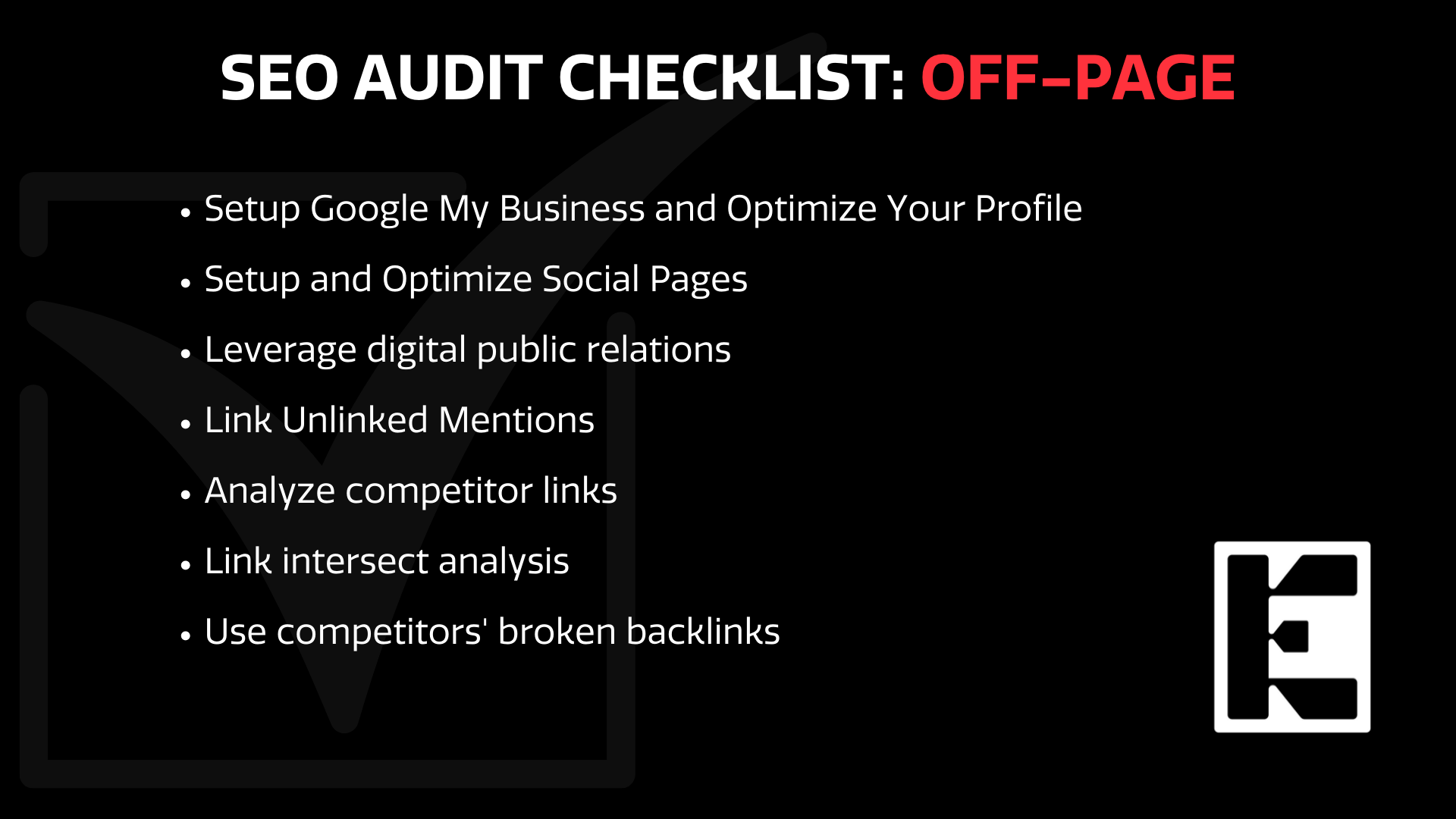
Search engines use backlinks to assess your content's quality. If a website has a high value, it generally ranks better than one with no or low-quality backlinks.
There are three main types of links needed for linkbuilding:
- Natural
- Manual
- Self-created
Natural links are when other sites link to your content on their own. Manual links are built deliberately by asking customers and influencers to share your content. And self-created links are usually through an online directory, blog comment signature, forum, or press releases with anchor text.
Audit Checklist: Off-Page SEO
- Setup Google My Business and Optimize Your Profile
- Setup and Optimize Social Pages
- Leverage digital public relations
- Link Unlinked Mentions
- Analyze competitor links
- Link intersect analysis
- Use competitors' broken backlinks
You can use the Semrush Backlink Gap tool to compare your backlink profiles with your competitors.
EmberTribe: Search Engine Optimization services you can rely on
If developing an SEO strategy on your own seems daunting, you can find affordable SEO services at EmberTribe. We build marketing systems, including organic SEO strategy and paid traffic.
Let us help you set up your marketing strategies for long-term success. Schedule a call with a growth expert today to find out how we can help.


-AK-148968-preview.png?width=842&height=310&name=1.01-1x1px-Embertribe-(Client-Services)-AK-148968-preview.png)













.png?width=810&height=810&name=TJ%20Jones%20-%20%20CoFounder%20EmberTribe%20(1).png)


%20-%20500x500%20-%20SP%20-%2045.01.png)
%20-%20500x500%20-%20SP%20-%2049.01.png)
%20-%20500x500%20-%20SP%20-%2057.01.png)


.png)